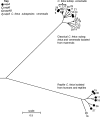Genetic relationships among reptilian and mammalian Campylobacter fetus strains determined by multilocus sequence typing
- PMID: 20053851
- PMCID: PMC2832409
- DOI: 10.1128/JCM.01439-09
Genetic relationships among reptilian and mammalian Campylobacter fetus strains determined by multilocus sequence typing
Abstract
Reptile Campylobacter fetus isolates and closely related strains causing human disease were characterized by multilocus sequence typing. They shared approximately 90% nucleotide sequence identity with classical mammalian C. fetus, and there was evidence of recombination among members of these two groups. The reptile group represents a possible separate genomospecies capable of infecting humans.
Figures


Similar articles
-
Occurrence and molecular characterization of reptilian Campylobacter fetus strains isolated in Taiwan.Vet Microbiol. 2013 May 31;164(1-2):67-76. doi: 10.1016/j.vetmic.2013.01.008. Epub 2013 Jan 29. Vet Microbiol. 2013. PMID: 23466328
-
Genetic divergence of Campylobacter fetus strains of mammal and reptile origins.J Clin Microbiol. 2005 Jul;43(7):3334-40. doi: 10.1128/JCM.43.7.3334-3340.2005. J Clin Microbiol. 2005. PMID: 16000457 Free PMC article.
-
Emergence of a tetracycline-resistant Campylobacter jejuni clone associated with outbreaks of ovine abortion in the United States.J Clin Microbiol. 2008 May;46(5):1663-71. doi: 10.1128/JCM.00031-08. Epub 2008 Mar 5. J Clin Microbiol. 2008. PMID: 18322054 Free PMC article.
-
Assessing the intra-species genetic variability in the clonal pathogen Campylobacter fetus: CRISPRs are highly polymorphic DNA markers.J Microbiol Methods. 2017 Jan;132:86-94. doi: 10.1016/j.mimet.2016.11.012. Epub 2016 Nov 17. J Microbiol Methods. 2017. PMID: 27867047
-
Clonal nature of Campylobacter fetus as defined by multilocus sequence typing.J Clin Microbiol. 2005 Dec;43(12):5888-98. doi: 10.1128/JCM.43.12.5888-5898.2005. J Clin Microbiol. 2005. PMID: 16333072 Free PMC article.
Cited by
-
Pathogenomics of Emerging Campylobacter Species.Clin Microbiol Rev. 2019 Jul 3;32(4):e00072-18. doi: 10.1128/CMR.00072-18. Print 2019 Sep 18. Clin Microbiol Rev. 2019. PMID: 31270126 Free PMC article. Review.
-
Homologous Recombination between Genetically Divergent Campylobacter fetus Lineages Supports Host-Associated Speciation.Genome Biol Evol. 2018 Mar 1;10(3):716-722. doi: 10.1093/gbe/evy048. Genome Biol Evol. 2018. PMID: 29608720 Free PMC article.
-
Whole-genome comparison using complete genomes from Campylobacter fetus strains revealed single nucleotide polymorphisms on non-genomic islands for subspecies differentiation.Front Microbiol. 2024 Sep 12;15:1452564. doi: 10.3389/fmicb.2024.1452564. eCollection 2024. Front Microbiol. 2024. PMID: 39328909 Free PMC article.
-
Living in Cold Blood: Arcobacter, Campylobacter, and Helicobacter in Reptiles.Front Microbiol. 2019 May 15;10:1086. doi: 10.3389/fmicb.2019.01086. eCollection 2019. Front Microbiol. 2019. PMID: 31191467 Free PMC article. Review.
-
Zoonotic and Public Health Implications of Campylobacter Species and Squamates (Lizards, Snakes and Amphisbaenians).Pathogens. 2020 Sep 28;9(10):799. doi: 10.3390/pathogens9100799. Pathogens. 2020. PMID: 32998205 Free PMC article. Review.
References
-
- Blaser, M. J. 1998. Campylobacter fetus: emerging infection and model system for bacterial pathogenesis at mucosal surfaces. Clin. Infect. Dis. 27:256-258. - PubMed
-
- Garcia, M. M., M. D. Eaglesome, and C. Rigby. 1983. Campylobacters important in veterinary medicine. Vet. Bull. 53:793-818.
Publication types
MeSH terms
Substances
Grants and funding
LinkOut - more resources
Full Text Sources

